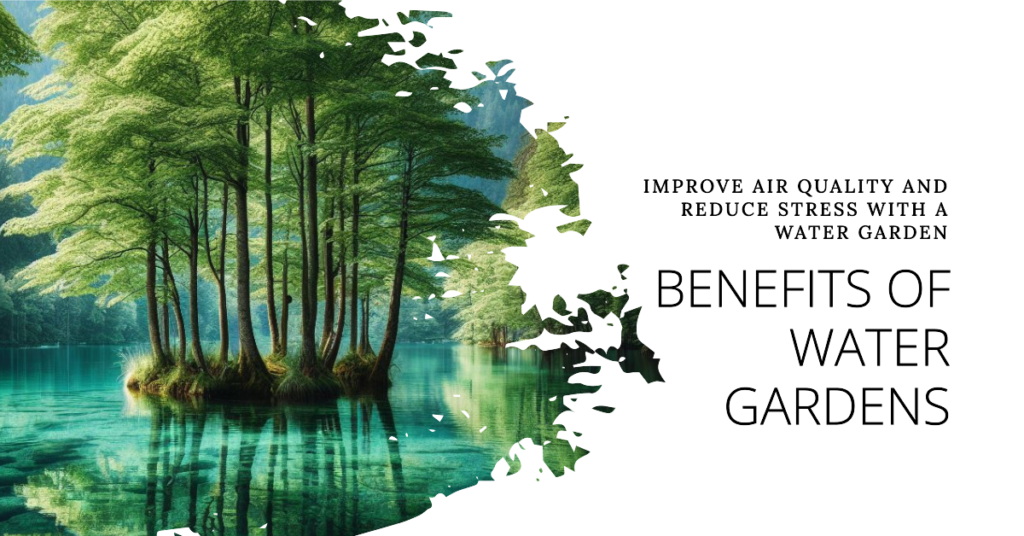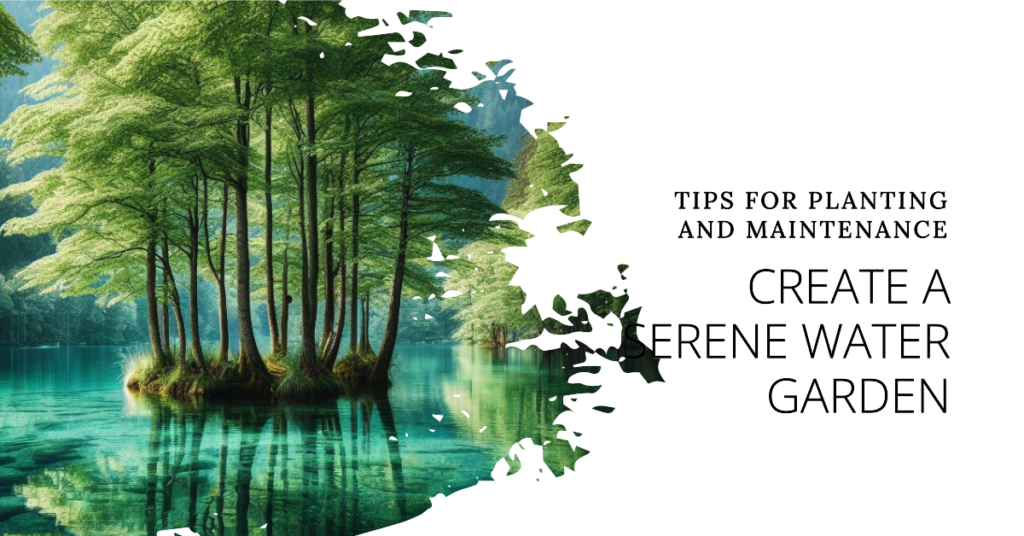Are you looking to add some greenery and improve the look of your outdoor space? Why not try water gardening and plant trees that grow in water? Water gardens are a great way to introduce color, texture, wildlife and sound into your garden while providing an effective way to conserve precious resources. With this guide to water gardening, you’ll learn everything there is to know about growing aquatic plants—so you can create a beautiful, eco-friendly landscape with peace of mind.
What are Water Gardens and their Benefits
Water gardens, also known as aquatic gardens, are designed spaces where water is the primary element used for growing various types of plants, including trees. They can range from small containers to large ponds, and create an aesthetically pleasing environment that’s also a haven for wildlife. There are several benefits to water gardens.

Firstly, water gardens help in conserving water as the same water is recycled for plant growth. Second, they promote biodiversity by welcoming a variety of aquatic species and attracting different types of birds and insects. Third, they bring a unique, tranquil beauty to any landscape.
Trees that grow in water, for instance, can provide shade and visual interest. Lastly, water gardens are generally low-maintenance, requiring less attention than traditional gardens once they are established. They offer the perfect blend of functionality and natural beauty, making them an appealing feature for any outdoor space.
Types and List of Trees That Grow in Water
Several types of trees thrive in water environments, making them excellent choices for your water garden.

- Weeping Willow (Salix babylonica): Renowned for its graceful, drooping branches, the Weeping Willow enjoys moist soil and can grow well near water bodies.
- River Birch (Betula nigra): An attractive tree with peeling bark that varies from tan to reddish-brown, the River Birch is a native of the Eastern United States and thrives in wet conditions.
- Bald Cypress (Taxodium distichum): This deciduous conifer grows well in a variety of conditions, including water-soaked soils. It is characterized by its needle-like leaves and distinctive “knees” that protrude from the water.
- Black Willow (Salix nigra): The Black Willow is a fast-growing tree that typically grows along streams and in marshy conditions. It provides excellent shelter for birds and other wildlife.
- Red Maple (Acer rubrum): While the Red Maple can adapt to a wide range of conditions, it particularly enjoys damp, water-logged soils. Its brilliant red leaves in the fall make it an attractive addition to any landscape.
- Swamp Tupelo (Nyssa sylvatica var. biflora): Swamp Tupelo, as the name suggests, is well-suited to soggy conditions. It is well known for its resistance to flooding and provides excellent cover for wildlife.
- Water-loving Cottonwood (Populus deltoides): This tree is known for its fast growth and tolerance to wet conditions. It also adds a dramatic effect to landscapes due to its height and broad canopy.
- Pond Cypress (Taxodium ascendens): Closely related to the Bald Cypress, the Pond Cypress thrives in water-logged soils. It is recognized by its narrow, columnar shape and delicate, feathery foliage.
- Green Ash (Fraxinus pennsylvanica): Green Ash is a versatile tree that can tolerate a wide range of conditions, including wet soils. Its beautiful yellow fall color adds a pop of color to your water garden.
- American Sycamore (Platanus occidentalis): This tree is a sturdy species that can tolerate wet soils. It has a distinctive peeling bark and can grow to be quite large, making it an impressive addition to any landscape.
These trees not only enhance the beauty of your water garden but also contribute to a balanced and thriving ecosystem. Remember, when planting trees in a water garden, ensure they are suitable for your climate and the specific conditions of your outdoor space.
How to Plant Your Trees in a Water Garden
Planting trees in a water garden requires a little more attention than planting them in dry soil, but with the right knowledge, you can do it successfully and enjoy a thriving aquatic garden.

- Choose the right location: Ensure the location of your water garden gets adequate sunlight. Most water-loving trees require at least six hours of full sun each day to grow healthy.
- Prepare the planting area: Before you plant, prepare the ground by removing any weeds, rocks, or other debris. If you’re planting in a pond, you’ll need a strong, durable pond liner to prevent water from seeping into the ground.
- Select the right tree: Choose a species of tree that is suited to your geographical location and can thrive in water-logged conditions.
- Planting the tree: Dig a hole that’s twice as wide and just as deep as the root ball of your tree. Place the tree in the hole, making sure the top of the root ball is level with the soil surface. Then, backfill the hole with the removed soil, gently firming it down.
- Watering: Once your tree is planted, water it thoroughly. The soil around the tree should be saturated but not waterlogged.
- Maintenance: Regularly check on your trees, especially during the first few months after planting. Keep an eye out for any signs of disease or distress.
Remember, patience is key when it comes to establishing trees in a water garden. It may take time for your trees to adapt to their new environment but with consistent care, they will eventually thrive and enhance the beauty of your water garden.
Tips for Planting and Maintaining a Water Garden
Maintaining a water garden can be a fulfilling experience, but it also comes with its set of challenges. Here are some essential tips to keep your water garden thriving:

- Choose the Right Plants: Not all aquatic plants are created equal. Ensure you choose the right plants for your water garden. Some plants require a lot of sunlight, while others can survive with less. Similarly, some plants need deeper water, while others are satisfied with shallow water.
- Monitor Water Levels: Ensure the water level in your garden is maintained, especially during dry spells. The water level can significantly affect the health of your water plants, especially the trees that grow in water.
- Keep the Water Clean: Regularly remove dead leaves and other debris from the water. This prevents the growth of algae, which can make the water murky and harm the aquatic life.
- Check for Pests: Regularly check your plants for any signs of pests or diseases. Early detection is key to preventing the spread and maintaining the health of your water garden.
- Prune Regularly: Pruning helps maintain the shape of your trees and keep them healthy. Remove any dead or damaged branches to encourage new growth.
- Use a Pond Liner: A good quality pond liner helps maintain the water level and prevents the water from seeping out. It also protects the roots of your plants from damage.
Remember, a well-maintained water garden not only enhances the beauty of your outdoor space but also provides a peaceful and tranquil environment where you can relax and unwind. Happy gardening!
Different Ways to Style Your Water Garden
Styling your water garden is an opportunity to showcase your creativity and make your outdoor space truly unique. Here are some ideas to inspire you:
- Create a Miniature Waterfall: A waterfall can add a dynamic, visual element to your water garden while also promoting oxygenation, which is beneficial to plants and wildlife. You can use stones or slate to form the waterfall and plant water-loving ferns and moss around it for a natural look.
- Add a Bridge: A small bridge over your water garden can not only improve accessibility but also add a charming, rustic feel to your outdoor space. Accompany it with flowering plants for a stunning visual impact.
- Install Lights: Incorporate underwater lights or floating lanterns to illuminate your water garden at night. This can create a magical, enchanting atmosphere.
- Incorporate a Gazebo or Sitting Area: Install a gazebo or seating area near your water garden. It offers a peaceful place to relax and enjoy the view.
- Use Statues or Other Decorative Elements: Adding statues or other decorative elements can give your water garden a unique character. Choose pieces that reflect your taste and blend well with your natural surroundings.
- Create a Theme: You can design your water garden based on a particular theme, such as a Japanese Zen garden or a tropical paradise. Select plants, trees, and decorative elements that align with your chosen theme.
Explore Different Plants You Can Add to Your Water Garden
In addition to trees, numerous aquatic and semi-aquatic plants can be incorporated into your water garden to enhance its beauty and diversity. Here are some options:
- Water Lilies (Nymphaea): Renowned for their iconic, floating leaves and stunning, colorful blossoms, water lilies are a must-have in any water garden. They provide shade for aquatic life and help suppress the growth of algae.
- Lotus (Nelumbo): Characterized by their towering, elegant flowers and large, round leaves, lotus plants add an exotic touch to any water garden.
- Cattails (Typha): These tall, slender plants with distinctive, brown, cylindrical flowers add height and dramatic appeal to the water garden. Cattails are also excellent at improving water quality by absorbing excess nutrients.
- Duckweed (Lemna): A floating plant that spreads rapidly, providing excellent cover for aquatic life.
- Pickerel Weed (Pontederia): This plant adds a lovely splash of color with its vibrant, purple-blue flowers. In addition to its aesthetic appeal, pickerel weed also provides a valuable habitat and food source for many types of wildlife.
- Water Clover (Marsilea): With its distinctive, four-leaf clover-like leaves, water clover is an attractive and interesting addition to any water garden.
Remember, when choosing plants for your water garden, it’s important to consider factors such as the amount of sunlight exposure, water depth, and the specific needs of each plant to ensure a healthy, thriving aquatic ecosystem.
Conclusion
Water gardening is a unique and rewarding endeavor that allows you to explore a whole new realm of horticulture. A well-maintained water garden not only beautifies your outdoor space but also creates a calming haven where you can unwind and connect with nature. It’s important to choose the right trees and aquatic plants that can thrive in water, and provide them with the necessary care to ensure a vibrant, thriving ecosystem.
Remember, every water garden is unique, and it’s an opportunity to express your creativity and personal taste. With proper planning, care, and maintenance, your water garden can become a fascinating, lush paradise that provides joy and serenity for years to come.
Frequently Asked Questions (FAQS)
What are some of the best trees that grow in water?
Some popular trees for water gardens include Willow Trees, Bald Cypress, and Red Maples, all of which can thrive in water-saturated conditions.
How often should I clean my water garden?
Regular maintenance is key to a healthy water garden. It’s advisable to remove debris and dead leaves weekly, whilst a thorough clean, involving partial water replacement, should be done annually.
Can I add fish to my water garden?
Yes, fish can be a great addition to your water garden. Koi and Goldfish are often popular choices. They contribute to a dynamic ecosystem and can help control mosquito larvae.
How much sun exposure do water plants need?
This depends on the plant species. However, most aquatic plants, especially lilies and lotus, require full sun exposure for at least six hours a day. Always check the specific needs of each plant.
Do aquatic plants need special fertilizer?
Yes. Aquatic plants do not receive nutrients in the same way as traditional soil plants and therefore require water-soluble fertilizers specially designed for aquatic use. Always be careful not to over-fertilize, as this can encourage algal bloom.





